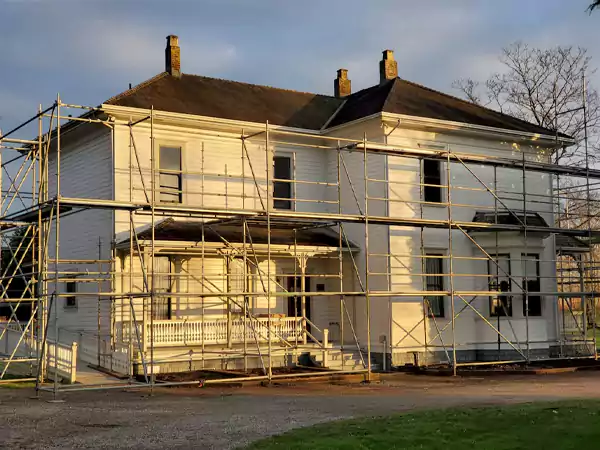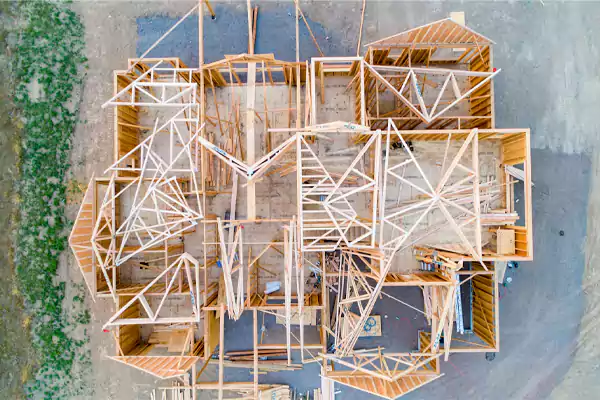Ans: The correct order is to buy land, hire a contractor, and then let the contractor do its work. Finally, you have to ensure the quality inspection before doing the full and final with your developer. For more, go through this article.

19 Steps to Building a House – Construct Your Dream Living Space With Precision

Building a dream house is many people’s life project, thus nothing must go wrong. If you are making plans to construct a residential property, this guide can provide great help through educating and discussing all the major steps to building a house. From the start to the closing of the development, everything is discussed below.
In the end, there is a brief section that outlines all the factors not to overlook when searching for the most suitable contractor. For more, continue to read till the end.
Follow 19 Steps to Building a House & Get Your Dream Residence Built!

Steps to building a house include in-depth research, hiring a general contractor, obtaining permits, site preparation (clearing, levelling, & foundation structuring), laying the foundation, installing footings, installing plumbing essentials into the foundation, building house frames, and applying sheathing initially.
Afterwards, there are tasks, such as fixing windows and doors, fitting HVAC systems, and setting up indoor utilities (Electrical Wires & Plumbing) before moving on to roof development. The process of roof development is followed by insulation coverage, painting, and final inspection.
Go through all of these below in greater detail.
1. Researching Your Favourite House Model
First things first, start by researching the house models that better align with your dream house vision. It depends on the key characteristics associated with each type available and how it serves your specific needs the best.
To make an informed decision, you might also need to hire a contractor so that they can help you decide swiftly without taking much time. For an affordable alternative, free resources related to residential architecture available on the internet can also be leveraged.
2. Hiring a General Contractor
Once you have decided on the design you want, it is time to talk to a general contractor. This professional in the construction industry who helps people get their dream development projects constructed efficiently.
Ensure that you only hire an experienced builder so that you don’t have to deal with any shortage of resources or inaccurate estimates later in the middle of the process. Construction estimating is an art that only contractors with years of experience can carry out properly.
3. Getting Permits from the Right Authorities
Obtaining all the required permits to start the construction process is the next crucial move among house construction steps. Constructing a residential project cannot start unless government authorities have provided written permission in the form of permits. Major such legal documents are as follows.
- Plumbing Permits
- HVAC Permits
- Building Permits
- Electrical Permits
- Others
The best practice to keep things hassle-free is to obtain all the necessary permissions with the help of a competent contractor. Hiring a well-qualified developer does not just help glide through complicated legal formalities, but also complete the construction in a very efficient way.
4. Clearing & Levelling the Site
Let’s now discuss two major steps to build a house once all the permits have been obtained. Now, the contractor needs to clear and level the site. If there are any trees, bushes, or rocks, the plot needs cleaning or clearing. Cutting a tree from its base isn’t difficult, as the most challenging part is to uproot it. Taking all the roots out helps keep regrowth at bay.
Furthermore, once all the unwanted parts are removed, it is time to level the ground so that the foundation work can begin. If all the highs and lows of the ground surface aren’t evened out, it will create trouble while laying the foundation.
5. Preparation for Foundation or Basement
The foundation is the most important and the first part constructed in residential developments or other construction types. A strong foundation or basement area is what defines the strength of a build. During this stage, with the help of wooden frames, the foundation measurements are established with accuracy and precision. Next, utilities & septic systems are installed for future purposes.
6. Installing Footings
While building a house step by step, we have now come to the installation of footings. This is where the expertise of a general contractor comes into play. A project owner can choose to either use concrete or brick masonry for the structure. Footings are commonly used for shallow foundations. At the same time, footing drains are also built to keep the structural components away from damage caused by unwanted water discharge.
7. Pouring the Foundation
Now, at the 8th stage, out of all the steps in building a house, it is time to begin with pouring the foundation of the build. Shallow and deep are the two major foundation options to choose from. Suppose your project isn’t that heavy, meaning it is not a multi-story building.
In that case, slabs, crawl spaces, and basements—any of these shallow foundation techniques will be sufficient to create a strong base. However, for a heavy residential property, even of a tiny sort, piles are used for constructing a deep foundation.
8. Installing Drains, Sewers, & Taps
After the foundation structure is ready as per a client’s preferences, installing drains, sewers, and taps assumes importance. Now, the contractor needs to make sure that all the plumbing essentials are well-established in the foundation before trenches are filled with concrete. An experienced contractor won’t take much time to finish the foundation. However, if the project is big, it might take a little more time to ensure quality work.
9. Inspecting the Foundation
The 10th stage in the essential house building steps is related to the inspection of the foundation that has been laid down so far. Not just finishing a particular aspect of a project matters, but also how it is done! Quality development is what counts long-term.
So, now, a team of residential construction inspectors will come over to the site and check the newly developed base of the house for potential errors. If there is anything majorly wrong, the competent inspector will discuss it with the contractor and sort it out in due course of time.
10. Building the Frame of the House
Once the base/foundation is all okay, as approved by the inspector, next comes framing. This is where your house starts to take its shape and upper structure. This is what comprises the 11th step of how to build a house step by step. In framing, lumber is erected to mimic the future positions of walls, flooring, ceiling, roof, etc., of the first floor of the house.
11. Applying Sheathing to External Walls
The framing provides the initial shape for a particular house and its design. But, no matter how strong and hard wood items (or lumber) are used, the frame, once erected, is bound to be fragile, as there are huge spaces in between. Thus, it is time to make it strong with the help of hard, flat wooden panels, like plywood panels. The process is called sheathing, and it is applied externally to the frame.
12. Installation of Windows & External Doors
The 13th task, out of the steps for building a house, is associated with creating outlets for seamless outdoor-to-indoor connectivity. This is achieved by installing windows and external doors to the initially sheathed structure of the house. It is also very important that such openings in the house are energy-efficient as well, so that they will help keep indoor temperatures at the optimal level.
13. Putting the HVAC System in Place
At this stage, usually a general contractor begins the work of properly installing the HVAC system. However, other developers might first want to conduct a thorough inspection of the framing before moving any further. HVAC stands for Heating, Ventilation, and Air Conditioning, and it is a crucial consideration among the major steps to building a house checklist.
14. Rough Plumbing & Inspection
Before the walls and ceilings are closed completely, the plumber is required to do their work with respect to setting up water supply lines, drain systems, and vent pipes. The general contractor that you hire to complete the entire construction will contract with several subcontractors to complete this utility work. Once the work is done, a complete assessment will be carried out to check if everything is finished with accuracy.
15. Setting Up Electrical Wires & Panels
So far, we have discussed a step by step home building process, and thus, next comes the time for setting up electrical wires. An electrician is called in to complete this task and ensure a quality inspection. If necessary, your house builder might have to hire more than one electrician to speed up the process.
16. Roof Development
Once all pipes and wires are done for utilities, the roof is paid all the attention. The roofing is the most significant part of the house. It protects the entire structure from the negative consequences of the elements, along with walls! The framing of the roof has already been completed. Now, it is time to finalise it with strong materials, such as clay, concrete tile, metal slate, or wood, as per the preferences of the owner.
17. Insulation Coverage & Drywall
In residential development, insulation and drywall are both very crucial aspects and thus work hand-in-hand to ensure a comfortable indoor atmosphere. Insulation minimizes heat transfer, while drywall makes the house interior fire- and sound-resistant. At this stage, the builder will thus ensure proper insulation with drywall-related aspects.
18. Painting & Exterior Finishes
Once all the rest is done, it is time to make your house look the best version of itself with your favorite colors. Pick up the best options from all the available paints and fill your house walls and other structures with the true vibrancy of life. Choose different types of external siding to add an element of protection and aesthetics to external walls.
19. Final Inspection & Closing
The final step to build a house comprises inspection sessions for the last time before closing the process legally. So, a residential property inspector comes when the development is complete to ensure that all aspects are built with safety and security. Doing so is crucial; as the saying goes, ‘prevention is better than a cure!’
This has been a brief discussion on how a typical house is built with the help of a general contractor.
Also Read: What is a Submittal in Construction? Learn How Submittals Work and Why You Need to Focus on Them
How to Hire a General Contractor for House Construction Step By Step?

Hiring a general contractor requires a project owner to take care of certain things, such as defining the project scope, relying on quality research and recommendations, and never failing to check a professional’s credentials. Furthermore, talk to multiple service providers to avoid being charged too much. Compare quotations to get the most affordable and reliable deal. And, before signing a contract, read all the terms carefully.
- Define Your Project: Make sure you are very clear about what type of house you want, including all features, aesthetic elements, foundation type, roof type, etc. It will help the contractor understand your needs better, and you will get value for your money!
- Research & Recommendations: Before you hire anyone, never forget to do thorough research about all the available service providers on the internet. Consider all the options and also ask people you know for referrals, as this can lead to meeting reliable contractors.
- Verify Credentials: A house builder must have a license to validate their authority in the field. Furthermore, don’t forget to check reviews shared by previous clients or customers.
- Talk to Multiple Contractors: Don’t finalize the deal with the first contractor you meet. Discuss your project with multiple builders, and it will provide you with the right perspective as to how much cost is reasonable.
- Ask for Detailed Estimates: From each residential developer you meet, ask for a detailed quotation. Once you have collected enough, compare and find which option is reasonable.
- Go Through Contracts Carefully: After hiring a professional, when it comes to closing a deal, never ever sign a written agreement unless you have studied all the general terms and conditions of the contract thoroughly.
Once you have hired a general contractor, don’t think that your work is complete. Instead, it has just begun. Thus, don’t forget the quality inspection. Conduct periodic checks during the construction to ensure that the work is happening in the desired quality manner. If you don’t have time, deploy a qualified inspector to do the same for you.
Also Read: 10 Biggest Construction Companies in the US to Know Before Hiring a Contractor!
Conclusion
All major steps to building a house have been discussed above. If you still have any doubts, you must connect with an experienced contractor. They will not just clear your doubts from their reservoir of practical wisdom but also guide your path in making the right decisions about design, materials, foundation type, etc. Building a house is a complex process, as it requires expertise, competence, qualification, and enough experience.
Also Read: Builders Risk Insurance: Everything You Must Know About
FAQs
Q: What is the correct order to build a house?
Q: How to find the best contractor to build a house?
Ans: Conduct thorough online and offline research and try to connect with as many service providers as possible. Ask for estimates so that you can make comparisons later to find the best option. If possible, get referrals from acquaintances.
Q: What is the best alternative to a costly traditional house?
Ans: If you cannot afford a conventional house from the foundation, consider tiny house options. You can buy a unit in a microapartment or even convert your bus into a movable home. It will be smaller, but you will have your own living space to relax and chill.